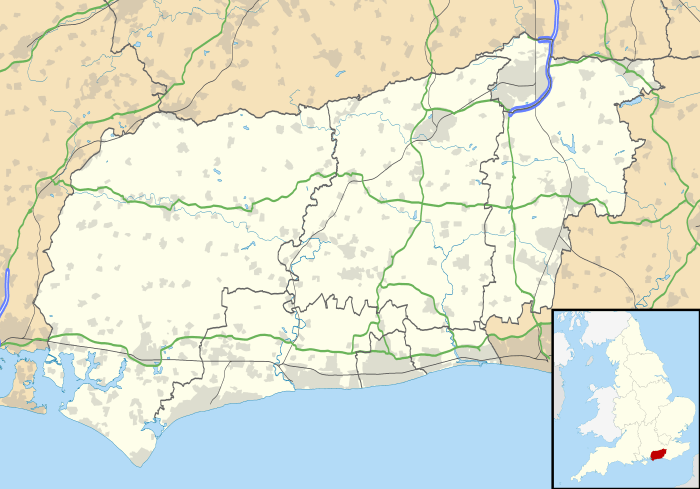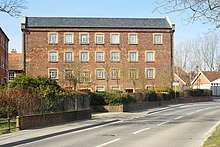Westhampnett
| Westhampnett | |
|---|---|
| Village | |
|
Church of St Peter | |
 Westhampnett Westhampnett shown within West Sussex | |
| Area | 8.89 km2 (3.43 sq mi) [1] |
| Population | 709. 2011 Census[2] |
| • Density | 52/km2 (130/sq mi) |
| OS grid reference | SU883062 |
| • London | 53 miles (85 km) NNE |
| Civil parish |
|
| District | |
| Shire county | |
| Region | |
| Country | England |
| Sovereign state | United Kingdom |
| Post town | CHICHESTER |
| Postcode district | PO18 |
| Dialling code | 01243 |
| Police | Sussex |
| Fire | West Sussex |
| Ambulance | South East Coast |
| EU Parliament | South East England |
| UK Parliament | |
Westhampnett (or West Hampnett[3]) is a village and civil parish in the district of Chichester in West Sussex, England, located 1 mile (1.6 km) northeast of Chichester on the former A27 road, now by-passed. The village is pre-Norman and is home to a large number of listed buildings, including the Saxon church of St Peter, where three bishops of Chichester are buried. The parish of Westhampnett includes most of Goodwood estate, its golf course, motor racing circuit and airfield.
History
Westhampnett was a Saxon settlement which passed into Norman hands after the Conquest.[4] The present village is a scattering of houses around an Anglican parish church of Saxon origin, dedicated to St Peter.
Westhampnett Poor Law Union was established in 1835, ecompassing many surrounding parishes.[3] Westhampnett's own workhouse was in existence until a fire destroyed it in 1899. The building had existed since the 16th century, and was leased to the Guardians of the Union by the Duke of Richmond.[5] The house had been rebuilt by Sir Hutchins Williams in about 1720.[4]
Two public houses existed in the parish: The Swan in the southwest, and the Coach and Horses at Maudlin. These, and a disused brickworks, are shown on an 1898 map.[6]
Civil parish
The civil parish includes the hamlets of Maudlin (on the Roman road Stane Street, now the A285) and Waterbeech to the northeast, and Westerton and Woodcote to the north.[7] Maudlin derives its name from the former small hospital of St Mary Magdalen.[4] To the north the parish extends just to Goodwood Racecourse high on the South Downs, including Goodwood House and most of Goodwood Airfield and motor racing circuit. The parish has a land area of 888.52 hectares (2,195.6 acres). In the 2001 census 460 people lived in 161 households, of whom 234 were economically active.[1]
Church
The parish church of St Peter, a Grade II* listed building,[8] was a Saxon construction dating from before the Norman Conquest, and incorporates Roman bricks in the structure. The church is mentioned in the Domesday Book. It was enlarged in the 13th century and added to in later centuries, the Roman brick chancel arch being replaced. The church has three bells: one undated, the others dated 1581 and 1632.[4] The churchyard contains an unusually large number of elaborate headstones, including plain and Celtic crosses, indicating a wealthy congregation in past centuries.
School
The March Church of England Primary School, in Claypit Lane, is next to the parish church.[9]
RAF Westhampnett

The airfield began as a World War II fighter base, opened in 1940 during the Battle of Britain when it was home to two Spitfire squadrons. It was later used by the United States Air Force fighter squadrons, flying British Spitfires and Typhoons.
Goodwood
The Goodwood Estate, family seat of the Dukes of Richmond, forms a large part of the parish of Westhampnett. It is the venue for the annual Goodwood Festival of Speed, a hill climb in the grounds Goodwood House, and Goodwood Revival, at the motor racing circuit. Goodwood racecourse is at the north end of the estate.
Notable places and people

Between Westhampnett church and Maudlin is the Rolls-Royce Motor Cars assembly plant, producing and testing the finished cars. Just to the south of the church is Chichester District’s main waste recycling centre. Towards Chichester is the former Westhampnett Mill, a watermill on the River Lavant, and a Grade-II listed building; it is constructed with red brick and is dated 1772.[10] There are 46 other listed buildings in the parish, including three Grade I at Goodwood House.[11]
Three consecutive Bishops of Chichester are buried at Westhampnett: Ashurst Gilbert (in office 1842-1870), Richard Durnford (1870-1895) and Ernest Wilberforce (1896-1907). In the church there is a monument to 16th century MP Richard Sackville. England cricketer James Lillywhite (1842-1929) was born in the village and is buried at St Peter's.[4] Lillywhite was a member of England's first Test team in the first ever Test match in 1877 against Australia and was the first captain of the England team.
References
- 1 2 "2001 Census: West Sussex – Population by Parish" (PDF). West Sussex County Council. Archived from the original (PDF) on 8 June 2011. Retrieved 25 May 2009.
- ↑ "Civil parish population 2011". Retrieved 15 October 2015.
- 1 2 "GENUKI: West Hampnett". Retrieved 20 October 2017.
- 1 2 3 4 5 "British History Online: Westhampnett". Retrieved 20 October 2017.
- ↑ "National Archives: Westhampnett Union". Retrieved 24 October 2017.
- ↑ "National Library of Scotland: Gazeteer". Retrieved 24 October 2017.
- ↑ "A Vision of Britain: Westhampnett AP/CP". Retrieved 20 October 2017.
- ↑ "British Listed Buildings: St Peter's, Westhampnett". Retrieved 24 October 2017.
- ↑ "March CE Primary School". Retrieved 20 October 2017.
- ↑ "British Listed Buildings: Westhampnett Mill House". Retrieved 20 October 2017.
- ↑ "British Listed Buildings: Westhampnett". Retrieved 20 October 2017.
External links
| Wikimedia Commons has media related to Westhampnett. |